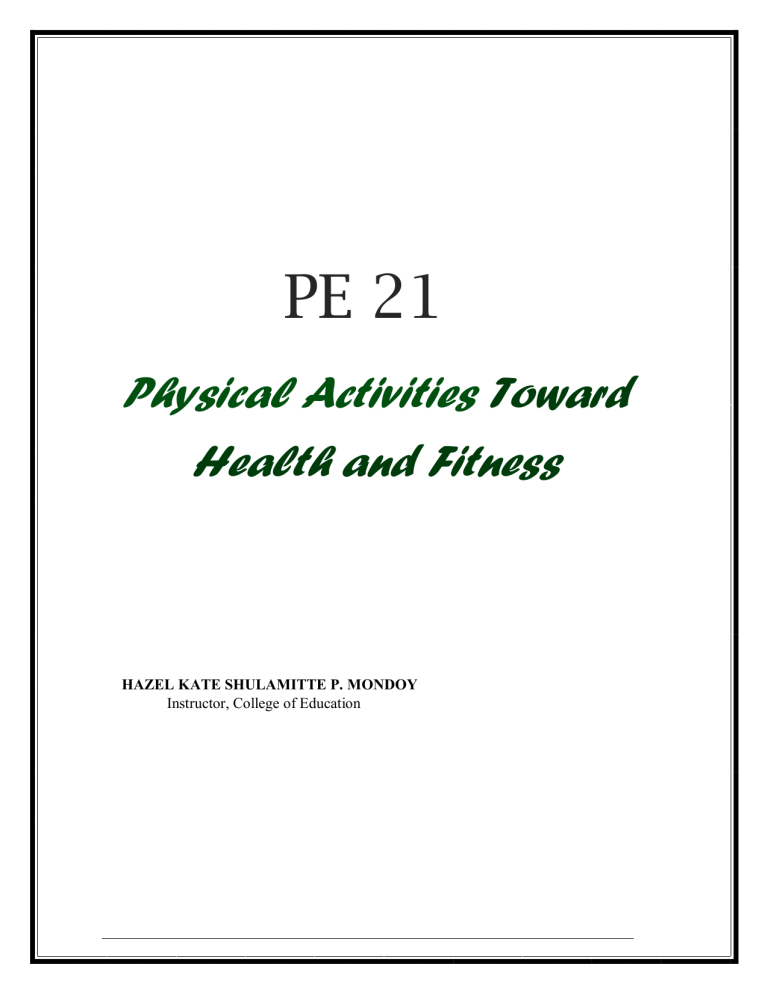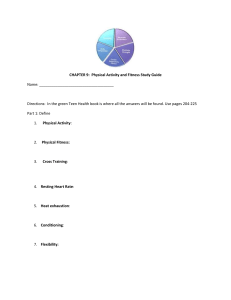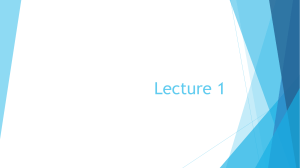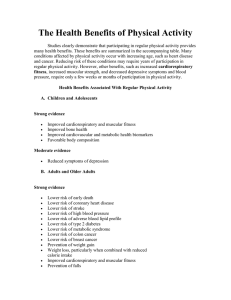
PE 21 Physical Activities Toward Health and Fitness HAZEL KATE SHULAMITTE P. MONDOY Instructor, College of Education Physical Activity for Optimal Health and Fitness “Lack of activity destroys the good condition of every human being, while movement and methodical physical exercise save it and preserve it.” —Plato (427–347 BCE) Introduction Participating in physical activity and exercise are important health maintenance strategies for people of all ages—children, youth, adults, and seniors. If being physically active is to become a part of a person’s lifestyle, it will be important to make a positive emotional connection to the activities of choice. In other words, there needs to be a feeling that physical activity is enjoyable and fun. Part of feeling that physical activity/exercise is fun is achieved by simply making it a habit. This lesson focuses on the many benefits of physical activity and exercise. The benefits are organized into three categories: physical fitness, health, and mental-emotional benefits. Key Understandings Physical activity contributes to fitness, health, and mental-emotional benefits. Specific benefits are associated with selected physical activities. There are key benefits of physical activities at various life stages. Background Information Fitness Benefits of Physical Activity Regular physical activity increases the body’s capacity and efficiency for work (performing movement), reduces the risk of injury and disease, and positively affects body composition (increased muscle mass, increased bone mass, and decreased fat mass). Movement places increased demands on the cardiovascular, respiratory, muscular, skeletal, and nervous systems of the body. Each system benefits from an activity plan that has consistent and progressive increases in the level of work intensity (activities that are harder to do and take longer to complete). The body’s systems adapt to the increasing load, resulting in greater efficiency in these systems and thereby resulting in an increased ability to perform work. In other words, the body is able work longer and harder than it was able to before. After a person has achieved a new level of fitness, everyday tasks are no longer as difficult as they once were. We do not have to spend hours in a gymnasium to gain the fitness benefits of physical activity. Every time we throw a ball, swim a lap, or climb a flight of stairs, our five main body systems are adapting. If these activities are consistent enough, our overall fitness will improve. The human body responds well to consistent and progressive physical activity. Substantial improvements may be anticipated in cardiovascular and respiratory (heart, circulatory, and lung) function, muscular strength and endurance, flexibility, body composition, and the ability to respond to psychological stress. Some of the more noticeable changes resulting from physical activity may include increased heart and circulatory function and endurance, seen as a lower heart rate for a given activity and a lower resting heart rate increased muscular strength, seen as an ability to lift heavier loads or an increased ease in lifting lighter loads increased muscular endurance, seen as the ability to execute more repetitions without rest increased bone strength, seen as a decreased risk of fracture or injury increased joint range of motion or flexibility, seen as an ability to reach or move into body positions impossible to attain previously increased physical work capacity, seen as an ability to complete more work in a single bout (e.g., shovelling a driveway with lower risk of injury or adverse effect) improved body composition (more muscle, stronger bones, and less body fat) Health Benefits of Physical Activity The health benefits of physical activity and exercise are well researched and documented. In addition to benefiting the cardiovascular, respiratory, muscular, skeletal, and nervous systems, physical activity and exercise also have a positive effect on the endocrine (hormonal responses) and immune (ability to defend against infection) systems. Because physical activity and exercise have such a wide-ranging effect on all the body’s systems they have been referred to as having a systemic effect. Systemic means system wide—across all body systems. Evidence shows that regular physical activity and exercise can reduce the risk of many diseases and conditions, as well as having many other health benefits: Physical activity and exercise reduce the risk of diseases and conditions such as: heart attack or heart disease second heart attack stroke colon, lung, breast, prostate, and many other cancers high cholesterol and triglycerides (fats) high blood pressure (hypertension) abnormal blood sugar levels type 2 diabetes osteoporosis (reduced bone density) pain arthritis and total hip or knee replacements depression and anxiety sleep apnea Physical activity and exercise can also result in benefits such as: improved pain tolerance improved self-esteem improved immune system better posture and balance decreased incidence of unintended falls greater energy improved sleeping habits faster recovery from injury or surgery increased high-density lipoproteins (HDL, or the “good” cholesterol) increased potential to achieve and maintain a healthy body weight by burning calories improved work capacity improved nervous system (better neurons) Mental-Emotional Benefits of Physical Activity Physical activity participation provides children and youth with opportunities for growth and development far beyond the obvious health benefits. Participation in sport, exercise, and physical activity also helps individuals develop social skills, such as sharing, taking turns, cooperating, and learning about winning and losing develop physical skills (e.g., coordination, posture, balance), locomotor skills (e.g., running), and manipulation skills (e.g., using a racquet or hockey stick), which contribute to a person’s self-efficacy develop a sense of belonging (when doing things with others, either in casual or organized activities and sports) develop family relationships (when parents play and exercise with their children and support their children’s sports) achieve academically in school prevent or control risky behaviours, such as the use of tobacco, alcohol, or other substances, unhealthy diets, or violence develop increased self-discipline, greater self-esteem, and a healthier body image increase opportunities to take on leadership roles, deal with adversity, and develop the ability to manage time How is physical activity defined? It is an all-encompassing term that includes exercise, dance, sports and leisure activities. It is generally defined as: bodily movement that is produced by the contraction of skeletal muscle and substantially increases energy expenditure. • What is Exercise? Exercise is planned, structured and repetitive bodily movement for recreation, leisure or fitness usually performed to improve one or more components of physical fitness, health or social interaction. • Moderate Physical Activity: Activity that is energetic but at a level at which conversation can be maintained. • Vigorous Physical Activity: Activity at a higher intensity, which may cause sweating and puffing. Activity 1. Make a reaction paper about the two videos "Why some vigorous activity could save your life?" and “Why is physical education a student’s most important subject?” Integrate your ideas into one body of reaction paper. The rubric is provided on the next page. • Why some vigorous activity could https://www.youtube.com/watch?v=dC7y9qB3tcA Why is physical education a student’s most important subject? https://www.youtube.com/watch?v=azuBmRnRYpo • save your life? RUBRIC FOR REACTION PAPER Trait Introduction Information summary Critique Conclusion Exceeds (5) Introduces theme of the video using rich and descriptive language. Provides accurate and descriptive, concise summary of article information, effectively summarizing main Points. Thoughtfully critiques speakers(s)’ main points, using evidence to back up arguments. Critique is insightful and thorough. Meets (4) Introduces theme of the vide effectively Below (3) Fails to present the theme, or fails to provide introduction Summarizes main points of the articles competently and accurately. Fails to summarize articles effectively due to omission of key points or inaccurate characterization of information. Fails to effectively present critique; and/or fails to use evidence to back up arguments; and/or uses flawed logic to support statements. Conclusion presents particularly strong or compelling closing statement that ties closely to introduction. Effective conclusion is presented that corresponds with introduction. Speaker(s)’ main points, using evidence to back up arguments. Missing or inconsistent conclusion. Organization Information is organized in a fully effective manner; presents strong introduction, expressive body, and purposeful Conclusion Sentences effectively constructed with no Sentence Structure grammatical errors Mechanics Spelling, capitalization and punctuation error‐ free Information is organized Missing or ineffective competently, with elements. thesis, supporting information and conclusion. Sentences effectively constructed with 1‐2 minor grammatical errors 1‐2 minor errors in spelling, punctuation or capitalization Repeated errors in sentence structure or grammar More than 2 errors Note: Avoid plagiarism. Plagiarism is presenting someone else’s work or ideas as your own, with or without their consent, by incorporating it into your work without full acknowledgement. Plagiarism checker: https://plagiarismdetector.net/?__cf_chl_jschl_tk__=pmd_xU8Rs.luTAVdxmPZ4VIoDd8p6hs7ZjOl9VIsE4H6 W Uo-1633576728-0-gqNtZGzNAjujcnBszQjR Write here! GREAT JOB! CONTINUE LEARNING. Last Name: ____Gador__________ Schedule Time: 1:00 pm – 3:00 pm First Name: __Rhena_______ and Day: Friday "Why some vigorous activity could save your life?" Vigorous activity, it is Activity at a higher intensity, which may cause sweating and puffing. In this activity it can go through a healthy body, it makes our body stay healthy which can lead to a long life and can save our life. Having a healthy body is just like a dreams that you wanted to have because only you, yourself can benefits the positive effects of having a healthy body, and can reduce the risk of many diseases and conditions. Current physical activity guidelines promote the health benefits of both moderate and vigorous activities, leaving individuals to choose their activity patterns according to their preferences and abilities. However, emerging evidence indicates that independent of the volume of activity engaging in some vigorous activity may provide additional health benefits. The fist video, I gain knowledge that vigorous activity would be something more intense that makes us sweat, puff, and pant and on a scale from about 1-10 of exertion, would be about a 7 or an 8. The World Health Organization recommends that adults should accumulate at least 150 minutes of moderate activity per week, only 2.5 hours, not a lot or alternatively, 75 minutes of vigorous activity, or the equivalent combinations of the two, when it say equivalent, it means one minute of vigorous activity counts as much as two minutes of moderate activity because the energy expenditure is about twice a high. Basically, these recommendations, these amounts of activity are based on the activity energy expenditure. And moderate activity would be like walking a dog or going for a casual bike ride, that something that noticeably increases your heart rate but doesn’t make us sweat. Vigorous activity is more efficient in inducing cardiorespiratory fitness that moderate activity, independent of the activity energy expenditures. And there is a studies found that this cardiorespiratory fitness is a better predictor of mortality than physical activity. We get a lot of health benefits out of being physically active. Even from just a walk, we get so many benefits like it can reduce high blood pressure, it can reduce the risk of heart disease, reduce type 2 diabetes, some cancers, risk of dementia, and also it boost our immune system. And those people who are physically active live longer. In the said findings, actually are not in line with those physical activity guidelines, because they found prophesied at the beginning, that vigorous activity has health benefits beyond just the higher energy expenditure and that future physical activity guidelines should continue to say that moderate activity is great for us, but should maybe point out more, the additional benefits we can all get out of vigorous activity. If we’re not doing any physical activity, it would be great if we could start doing some activity, even if it’s just moderate activity like going for a brisk walk. And for those who are already pretty active, but just doing moderate activity, it would be great, we could get an additional benefit out of it, if we also did at least a little bit of vigorous activity, even if it’s just 20-30 minutes per week, which isn’t much. “Why is physical education a student’s most important subject? “ Physical education (PE) develop students’ capability and confidence to generate in a variety of physical activity that become a main part of their lives, both in and out of school. It improves motor skills and increases muscle strength and bone density, which makes the students more likely to engage in healthy activity outside and inside the school. Physical Education class is a practice field where these character traits can be improve and developed. Furthermore it educates children on the positive benefits of exercise and allow them to understand how good it make them feel. Exercise demonstrate and it is good for our body, but it also teaches flexibility and persistence and a host of other character traits that are necessary for a life well lived. Physical education has a transcendent value that is often undervalued, including social, intellectual and academic spaces. Professor Simon explores that not only would regular exercise decrease obesity and future disease, but it teaches children vital tools such as perseverance and resistance needed to be successful in their future. Regular physical activity can help children and adolescents improve cardiorespiratory fitness, build strong bones and muscles, control weight, reduces symptoms of anxiety and depression, and reduce the risk of developing health conditions such as heart disease, cancer, type 2 diabetes, high blood pressure, osteoporosis, and obesity. To those children who is not inactive may can lead to energy imbalance (e.g., expend less energy through physical activity than consumed through diet) and can increase the risk of becoming overweight or obese. Increase the risk of factors for cardiovascular disease including hyperlipidemia, high blood pressure, obesity, and insulin resistance and glucose intolerance. And to those children who are physically active tend to have better grades, school attendance, cognitive performance behaviors (e.g., on-task behavior). Higher physical activity and physical fitness levels are associated with improved cognitive performance among students. Physical education provided the children and adolescents opportunities and encourage to participate in physical activities that are appropriate for their age, that are enjoyable, and that offer variety. The national recommendation for schools is to have a comprehensive approach for addressing physical education and physical activity in schools. A high quality PE curriculum enables all children to enjoy and succeed in many kinds of physical activity.




